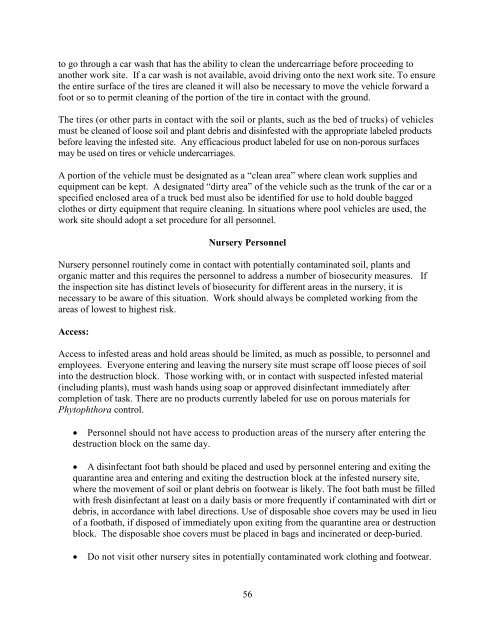Confirmed Nursery Protocol - aphis
Confirmed Nursery Protocol - aphis
Confirmed Nursery Protocol - aphis
You also want an ePaper? Increase the reach of your titles
YUMPU automatically turns print PDFs into web optimized ePapers that Google loves.
to go through a car wash that has the ability to clean the undercarriage before proceeding to<br />
another work site. If a car wash is not available, avoid driving onto the next work site. To ensure<br />
the entire surface of the tires are cleaned it will also be necessary to move the vehicle forward a<br />
foot or so to permit cleaning of the portion of the tire in contact with the ground.<br />
The tires (or other parts in contact with the soil or plants, such as the bed of trucks) of vehicles<br />
must be cleaned of loose soil and plant debris and disinfested with the appropriate labeled products<br />
before leaving the infested site. Any efficacious product labeled for use on non-porous surfaces<br />
may be used on tires or vehicle undercarriages.<br />
A portion of the vehicle must be designated as a “clean area” where clean work supplies and<br />
equipment can be kept. A designated “dirty area” of the vehicle such as the trunk of the car or a<br />
specified enclosed area of a truck bed must also be identified for use to hold double bagged<br />
clothes or dirty equipment that require cleaning. In situations where pool vehicles are used, the<br />
work site should adopt a set procedure for all personnel.<br />
<strong>Nursery</strong> Personnel<br />
<strong>Nursery</strong> personnel routinely come in contact with potentially contaminated soil, plants and<br />
organic matter and this requires the personnel to address a number of biosecurity measures. If<br />
the inspection site has distinct levels of biosecurity for different areas in the nursery, it is<br />
necessary to be aware of this situation. Work should always be completed working from the<br />
areas of lowest to highest risk.<br />
Access:<br />
Access to infested areas and hold areas should be limited, as much as possible, to personnel and<br />
employees. Everyone entering and leaving the nursery site must scrape off loose pieces of soil<br />
into the destruction block. Those working with, or in contact with suspected infested material<br />
(including plants), must wash hands using soap or approved disinfectant immediately after<br />
completion of task. There are no products currently labeled for use on porous materials for<br />
Phytophthora control.<br />
• Personnel should not have access to production areas of the nursery after entering the<br />
destruction block on the same day.<br />
• A disinfectant foot bath should be placed and used by personnel entering and exiting the<br />
quarantine area and entering and exiting the destruction block at the infested nursery site,<br />
where the movement of soil or plant debris on footwear is likely. The foot bath must be filled<br />
with fresh disinfectant at least on a daily basis or more frequently if contaminated with dirt or<br />
debris, in accordance with label directions. Use of disposable shoe covers may be used in lieu<br />
of a footbath, if disposed of immediately upon exiting from the quarantine area or destruction<br />
block. The disposable shoe covers must be placed in bags and incinerated or deep-buried.<br />
• Do not visit other nursery sites in potentially contaminated work clothing and footwear.<br />
56
















